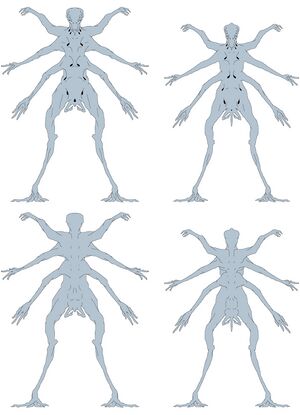Trrarrusian body (A1-0): Difference between revisions
No edit summary |
No edit summary |
||
| Line 5: | Line 5: | ||
The study of the Trrarrusian bodies includes multiple branches of anatomy, physiology, microbiology, chemistry, and oology. The trrarrusian body varies in known ways, both natural and artificial. All these studies ensures vital works as the cure of different trrarrusian diseases, a better understanding of the effects of implants and prosthetics, the creation of medicines used for enhancement of capabilities and the sustained health of trrarrusians in inhospitable locations, physiological rehabilitation of injured individuals, among others. | The study of the Trrarrusian bodies includes multiple branches of anatomy, physiology, microbiology, chemistry, and oology. The trrarrusian body varies in known ways, both natural and artificial. All these studies ensures vital works as the cure of different trrarrusian diseases, a better understanding of the effects of implants and prosthetics, the creation of medicines used for enhancement of capabilities and the sustained health of trrarrusians in inhospitable locations, physiological rehabilitation of injured individuals, among others. | ||
== Composition == | |||
Trrarrusians are a carbon-based specie, composed of various elements, specifically carbon, oxygen, hydrogen, nitrogen, phosphorus and titanium. These elements are located in both cellular and extracellular mass. | |||
The adult trrarrusian male body is composed of about 65% water in total, shared between extracellular fluids, blood plasma, interstitial fluids, and cellular fluids. The pH is carefully maintained rigorously, keeping a slightly alkaline pH level between 7.85 and 7.95 due to the high ammonia content required for metabolic processes. The most important electrolytes in extracellular fluids are potassium and chloride. Meanwhile, inside cells, the main electrolytes are sodium and phosphates. | |||
Revision as of 11:05, 19 August 2023

The trrarrusian body is the structure of the trrarrusian being. It is composed of different cells that form tissues with different functions, which ensure the existence of the individual, its interaction with the medium and the continuation of the specie.
It comprises a head (which holds most of the sensorial organs and the central nervous system), neck, torso (which holds most of the vital organs), arms and hands, and legs and feet.
The study of the Trrarrusian bodies includes multiple branches of anatomy, physiology, microbiology, chemistry, and oology. The trrarrusian body varies in known ways, both natural and artificial. All these studies ensures vital works as the cure of different trrarrusian diseases, a better understanding of the effects of implants and prosthetics, the creation of medicines used for enhancement of capabilities and the sustained health of trrarrusians in inhospitable locations, physiological rehabilitation of injured individuals, among others.
Composition
Trrarrusians are a carbon-based specie, composed of various elements, specifically carbon, oxygen, hydrogen, nitrogen, phosphorus and titanium. These elements are located in both cellular and extracellular mass.
The adult trrarrusian male body is composed of about 65% water in total, shared between extracellular fluids, blood plasma, interstitial fluids, and cellular fluids. The pH is carefully maintained rigorously, keeping a slightly alkaline pH level between 7.85 and 7.95 due to the high ammonia content required for metabolic processes. The most important electrolytes in extracellular fluids are potassium and chloride. Meanwhile, inside cells, the main electrolytes are sodium and phosphates.